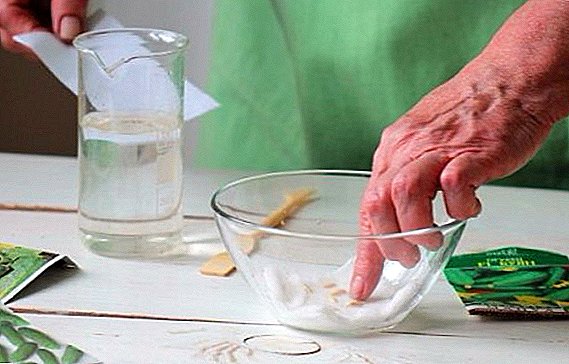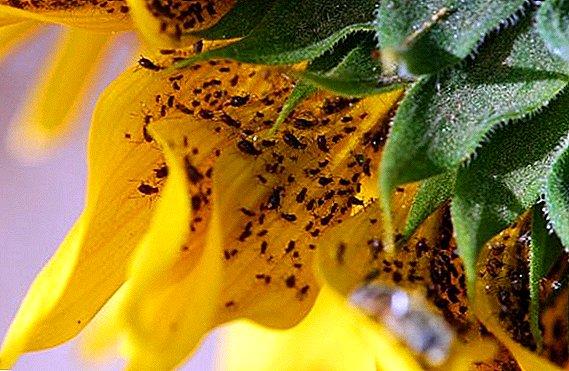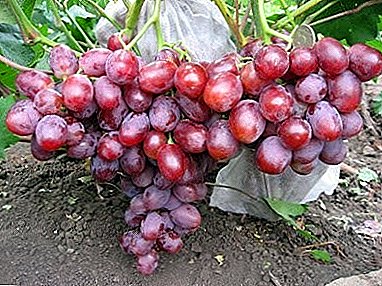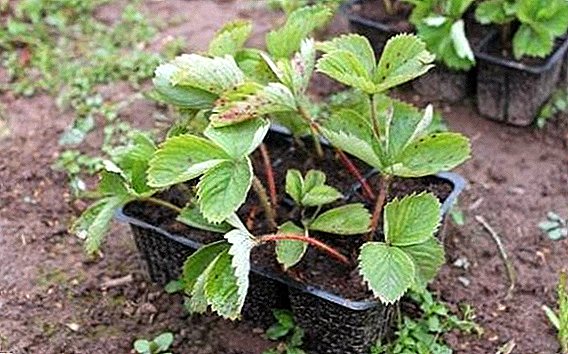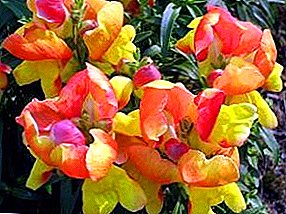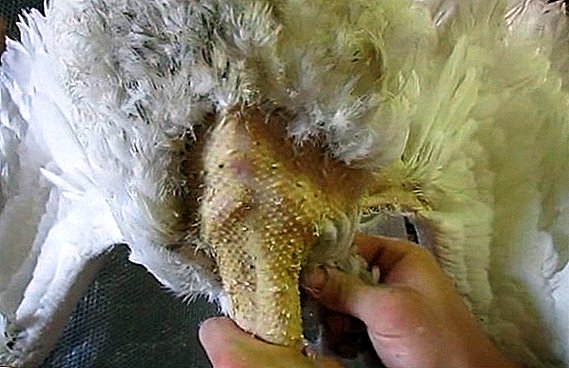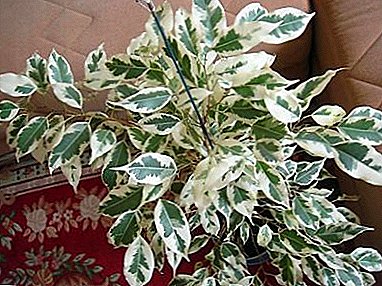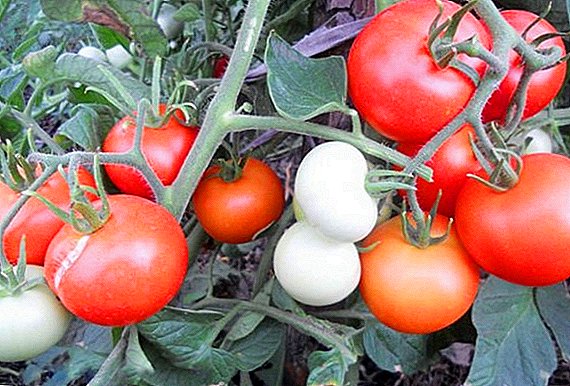 Being engaged in the cultivation of garden crops, we give preference to varieties that are more unpretentious and resistant to diseases and adverse conditions and require minimal maintenance.
Being engaged in the cultivation of garden crops, we give preference to varieties that are more unpretentious and resistant to diseases and adverse conditions and require minimal maintenance.
All these requirements are satisfied by the variety of tomatoes "Yablonka Rossii".
We will tell about its cultivation in this article.
Variety description
These tomatoes have determinative, strong and compact bushes.
Tomatoes with determinant bushes include such as "Katyusha", "Riddle", "Golden Heart", "Solerso", "Rio Fuego", "Superbomb", "Liana", "Bokele".
Plant height varies from 50 cm to 1 m. The plant is not very branched. Already above the 7-9th leaf, the first inflorescence appears. Leaves - potato type. Thanks to simple agricultural technology, this variety is also called "tomato for the lazy." 
It has the following advantages:
- early ripening of fruits and a long fruiting period;
- high yield;
- does not require pinching and garter;
- resistant to many diseases and adverse weather conditions;
- universality of fruits and good transportability;
- compact landing
This variety has practically no "minuses", but still its disadvantages include:
- demanding of the soil (prefers fertile);
- small sizes of fruits, but this is compensated by their sufficient amount;
- the likelihood of infection by blight and susceptibility to attack by the Colorado beetles, aphids and whiteflies.
Distinctive features include:
- harmonious ripening of fruits, which makes it possible to simultaneously process all products;
- bushes do not need stading and shaping.

Fruit characteristics and yield
This plant got its name because of the appearance, very reminiscent of an apple tree hung with fruits.
The variety is early ripe, tomatoes are ready for use on the 110-112th day of the emergence of shoots.
To early ripe varieties of tomatoes include such as "Samara", "Explosion", "Batanyan", "Caspar".
Ripening is friendly, so you can immediately collect and recycle, but the bush bears fruit until October.
Even with minimal cost, the yield per bush reaches 3-5 kg. If the plant is planted on fertile soil and fertilized, the number of tomatoes will increase. On average, up to 90-100 tomatoes ripen on one bush.
Fruit weight ranges from 70 to 100 g. Tomatoes are small in size, regular round shape with red skin. Fruits are dense and resistant to cracking, characterized by good transportability. 
They have universal use and are suitable for canning, cooking tomato paste, juice and various salads.
Did you know? One of the versions of the origin of the name "tomato" - from french [em] "pomme d'amour" [/ em] ("apple of love"). And for this there is reason. The fruit contains a substance similar to serotonin, which helps to relax and improve mood. This substance does not disappear even during heat treatment. Want to be in a good mood - Eat a tomato, a spoonful of tomato paste or drink juice.
Selection of seedlings
Tomatoes are heat-loving plants, and in order to get an early harvest, it is better to grow them through seedlings. You can put it yourself or buy it ready. 
Choosing seedlings, you need to pay attention to the following:
- leaves should have a rich green color, without spots and damage;
- stem - strong, well developed, not elongated;
- bushes should not be overgrown, otherwise they will take a long time to take root;
- the root system is well developed and covered with a lump of moist earth, and even better if the seedlings have already been transplanted into pots or cups.
Growing conditions
"Yablonka Rossiya" refers to undemanding crops, but for its cultivation it is still necessary to create certain conditions:
- These are heat-loving plants, and in the garden they should be planted in a sunny, well-warmed area.
- The soil should be moist but not waterlogged. In order to avoid rapid evaporation of moisture, the ground around bushes can be mulched with peat or humus.
- Tomatoes of this variety love fertile soil, so immediately when they are planted in the ground they add compost, humus, ashes and mineral fertilizers. The soil should be neutral or slightly acidic. Good loam.
- Suitable precursors can be cabbage, dill, garlic, cucumbers, beans or pumpkin. It is undesirable to plant after the nightshade, as they are subject to the same diseases.

Seed preparation and planting
Seeds are best purchased in specialized stores or via the Internet to be sure of the authenticity of the variety.
Important! Tomatoes do not like sour soil and an excess of organic matter in it.
You can start preparing seeds for planting in March.
And there are several ways to prepare:
- Soak for a couple of hours in warm water, and then in a weak solution of potassium permanganate (20 minutes). Dump in boxes or other container in the purchased soil or made up independently (ordinary earth + compost or humus). Depth of embedding seeds - 1.5-2 cm. Water, cover with film and put in a room with a temperature of 23-25 ° C. After emergence of shoots to remove a film. Place the container with seedlings in a bright place, and when you grow up a little, dive into cups or peat pots.
- Prepare a plastic strip with a width of about 20 cm and a length of 1-2 cm. On top of it put in 3 layers of toilet paper. Departing from the edge of 10 centimeters, and from the top - 1 cm, with a distance of 5 cm, apply a solution to stimulate root growth with a pipette or a rubber pear, and place 1 seed in each drop. Dampen the paper a little and roll it all up and secure with a rubber band. Make rolls in any container, cover with a film and put in a warm place. After 3-4 days, when the seeds hatch, fold the convolutions and sprinkle with earth (1 cm), roll again. Now make them into a container at the bottom of which sawdust is poured (they will absorb excess moisture). Top rolls well sprinkle with soil, pour, cover with a package and put in a warm place. Land should be watered periodically. When the germs appear above the roll, remove the bag and place the box in a well-lit place. After the appearance of several sheets, the bushes swoop into peat pots or plastic cups.

Usually, Yablonka Rossii is grown in seedlings, but in the south, seeds are sometimes sown in open ground, which, if necessary, is covered with foil or agrofibre.
Important! Tomato leaves are toxic and cause allergies in many people.
Maintenance and care
Seedlings well watered with a solution of ash: 1 tsp. 1.5 liters of water. Over-wetting should not be in order not to cause the appearance of a “black leg”. Pick in separate pots is carried out after the appearance of 4-5 leaves.
2-3 weeks before planting in open ground need to begin hardening, bringing plants to an open balcony or on the street. Drafts should be avoided. After steady warm weather (2nd half of May), plants aged about 2 months are planted in a permanent place.
The bushes and the roots of Yablonki Rossii are small, so the plants are placed at a short distance from each other (30 × 50 cm). When planting in the hole make humus (1 bucket per 1 m²) and ash (0.5 l per 1 m²). 
Further care for plants is as follows:
- The first feeding is carried out in 2 weeks. You can use commercial fertilizers containing phosphorus and potassium, and you can make wood ash, mullein, diluted with water in a ratio of 1: 5. At least 3 times per season, it is advisable to feed with a solution of ammonium nitrate (10 g), superphosphate (50 g) and potassium chloride (30 g) diluted in 10 liters of water. For dressings, "teas" are prepared, for the preparation of which various weeds are poured with water and kept until an unpleasant smell appears. For 10 liters of water used 0.5 liters of this tincture. This mixture of tomatoes watered every 14 days.
- Watering tomatoes should be in moderation, especially not filling. In cloudy weather, watering is not needed. Water pours under the root, because tomatoes do not like moisture on the leaves and fruits.
- Periodically it is necessary to remove the weeds. So that they grow smaller, the soil around the bushes is mulched with peat, humus or dry grass. It will also help preserve moisture longer and prevent the appearance of a crust on the surface of the earth after watering.
- Earth periodically loosened. Tomatoes respond well to hilling, which helps the formation of additional roots.
- If the bushes are many fruits, then they do not fall, they are tied up. But if the plants are low and strong (which is typical for the variety "Apple Russia"), then you can do without a garter.
- A characteristic feature of this variety is that there is no need to stepchild it.

Disease and pest prevention
Tomatoes, like all the nightshade, are very fond of Colorado beetles. For this reason, the bushes should be regularly inspected, and if you do not want to use "chemistry", then collect adult beetles and tear off the leaves with larvae. From chemical methods for spraying any drug from the Colorado potato beetle will do.
Aphid and whitefly can also be sown on tomato bushes. In this case, the plants are treated with insecticides, tobacco dust or tincture of wormwood.
Important! Phytophthora amazes tomatoes nWith an overabundance of moisture, thickened landings and sudden changes in day and night temperatures.
“Yablonka” is a variety resistant to many diseases, but it is affected by late blight. 
To combat this disease, chemical and folk methods are used:
- From "chemistry" for spraying apply "Epin", "Fitosporin", "Trichopol".
- There are a lot of folk methods. You can spray serum or milk in pure form or in solution with water (1:10) + a few drops of iodine; dust with ashes or water a solution of yeast. For this purpose, spraying every 10 days with garlic tincture with potassium permanganate (1 cup minced garlic + 1.5 g potassium permanganate per 10 liters of water) is suitable.
But to prevent the disease, it is better to use preventive measures:
- soaking the seeds before planting in a 1% solution of potassium permanganate for 20 minutes;
- fertilization with phosphorus and potassium;
- Do not overmoisten the soil and in cold weather to carry out surface loosening instead of irrigation.

Harvesting and storage
Yablonka Rossiya is an early ripe variety, and the fruits are ready for consumption in the last days of July - early August.
Fruits are characterized by good density and resistant to cracking, therefore, when harvesting, they are almost not damaged. In this regard, if they are not immediately recycled, they can be stored for a long time in a cool room.
Did you know? The shelf life of tomatoes will last, if you place them with the stems down. And green fruits will soon reach, if you keep them together with apples.
The remaining green fruits on the bushes are capable of ripening. They are stored on the floor, on the windowsill and even in the refrigerator. But remember that low temperatures impair the quality and taste of the fruit. 
Translated from Italian "tomato" means "golden apple". So our variety has a symbolic name. He has many supporters, but there are also opponents who say that the variety is old (he is over 20 years old), the fruits are small and not everyone likes the taste.
But we are sure that there are more lovers of Yablonki. Plant this tomato and you will surely like it. Good harvest and bon appetit!


